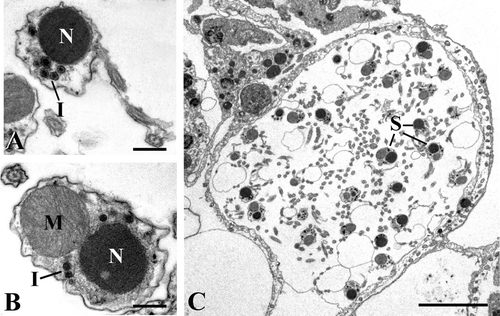Figures & data
Figure 1. Halichondria semitubulosa. A, sponge specimens in their natural environment (scale bar, 2 cm); B, semithin section showing choanocytes chambers (ChC) very close to one another (scale bar, 12 µm); C, Semithin section showing a spermatocyst (SC) near a choanocytes chamber (ChC) (scale bar, 12 µm); D, ultrathin section showing a spermatocyst (SC) and a choanocytes chamber (ChC). Note the debris (De) included in the cytoplasmic matrix. Sp I, spermatocytes of the first order (scale bar, 2 µm).

Figure 2. TEM micrographs of spermatogenetic phases.A, two spermatocysts (SC) at different stage of maturation. Note the layer of pinacocyte‐like cells (P) delimiting the cysts. F, flagella (scale bar, 5 μm); B, Spermatocytes of the first order (Sp I). M, mitochondria; N, nucleus (scale bar, 0.7 µm); C, spermatocytes of the second order (Sp II) connected by a cytoplasmic bridge (arrow). M, mitochondrion; N, nucleus (scale bar, 0.5 µm); D, a large mitochondrion (M) in the spermatocyte of the second order. Gl, glycogen; I, round‐shaped electron‐dense inclusions; N, nucleus (scale bar, 0.2 µm); E, spermatid. Note the presence of glycogen in the basal region of the tail (arrows). Gl, glycogen; I, electron‐dense inclusions; M, mitochondrion; N, nucleus (scale bar, 0.4 µm).

Figure 3. TEM micrographs.A, spermatozoon with electron‐dense nucleus (N) and inclusions (I) (scale bar, 0.5 µm); B, section of a spermatozoon showing the co‐presence of nucleus (N) and mitochondrion (M). I, inclusions (scale bar, 0.4 µm); C, an almost empty cyst including only some spermatozoa (S) (scale bar, 6 µm).
